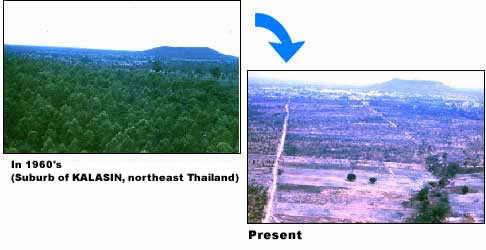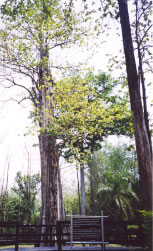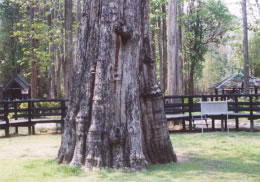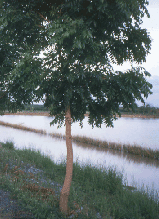![]()
<<<Thailand>>>
Large-scale deforestation to obtain foreign currency has been practiced in Thailand for many years, and most of the forests which covered half of Thailand in 1960's have disappeared. Government surveys show that today forested areas cover only 26% of the country. Furthermore, most of what were forests are now wastelands.

The two photographs shown above were taken at the same place; a suburb of KALASIN, a town in northeast Thailand. The mountain on the right-hand side of these photographs marks it as the same place. There was a tropical rainforest there in 1960's, but as most of the trees were razed, the land has become desolate. There are many more such ruined forest areas in Thailand.
The Thai government has promulgated a plan by which current
forested areas will be increased to 40%. To attain this goal, it is necessary
to return about 70,000 km2 of wasteland to forest.
| Total area of Thailand | 513.115km2 |
| Present forest area(26%) | 133.410km2 |
| Target total forest(40%) | 205.246km2 |
At the center of this reforestation activity is the Forest Industry Organization (FIO), part of the Ministry of Agriculture and Cooperatives(MOAC). FIO is involved in the planting of teak in northern Thailand, rubber trees in the south, and eucalyptus in the northeast and east.
 About 10-year-old Teaks Grown from Seedlings Prepared by Tissue Culture (by FIO) |
TGG has undertaken cooperative teak reforestation with FIO in Lampang Province, northern Thailand.
Teak , one of the trees selected for planting in Thailand, is indigenous to Southeast Asia. Because it is not an imported species, there is no anxiety about altering the ecosystem of the land.


1500-year-old Teak ( SAK YAI, Diameter:3.2m, Perimeter:~10m )
TGG signed a formal contract for this joint reforestation project in April 2003. During May-June 2003, together we finished planting 20,000 teak saplings on 32ha of the Mae Mai plantation in Lampang Province.


Signing Ceremony of the Contract on Cooperative Reforestation
Project between FIO and TGG (at MOAC in Bangkok, April 8, 2003)
Under this project, TGG is in charge of technology and funds, and FIO in charge of actual management. The teak saplings planted by FIO were produced from cuttings treated with our effective plant hormones, a technology developed by TGG. These saplings will be managed and protected by FIO employees for at least 30 years, after which the mature trees will be felled and their lumber sold, bringing a profit to Thailand. New saplings immediately will be planted on the cleared land after this.
To protect the planted trees from destruction by slash-and burn agriculture, we implemented a plan that contributes to the economic independence of the people living in the reforested area.
In our plan for this plantation, we incorporated the intercropping of a cash crop, in which the valuable teak trees are used as protection against wind and vermin.
During the first year of reforestation, income was obtained from upland rice, the intercrop. This intercropping has had various advantages; profit from the rice harvest, effective utilization of the plantation, and protection of teak saplings from weeds. Moreover, after the harvest the rice straw was used to make mulch and compost. The straw was decomposed by microorganisms and, as fermentable fertilizer, has provided nutrition to the trees.
We also planted other trees around the teak saplings to protect them from strong winds and noxious insects. The tree called SA-DAO in Thailand (neem tree in English) was selected as the protector tree. Its utility value is very high. The young leaves are used in cooking, and the tree provides good timber. Neem oil, extracted from its seeds, is a natural pesticide. Because of these assets, SA-DAO trees should provide a continuous source of income until the teak trees mature.

Neem Tree
To accomplish reforestation and support an area's economy, we at TGG do our best to provide the type of reforestation most suitable to the unique situation of each country.